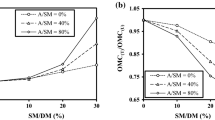Abstract
Lime–fly ash mixtures are exploited for the manufacture of fly ash bricks finding applications in load bearing masonry. Lime–pozzolana reactions take place at a slow pace under ambient temperature conditions and hence very long curing durations are required to achieve meaningful strength values. The present investigation examines the improvements in strength development in lime–fly ash compacts through low temperature steam curing and use of additives like gypsum. Results of density–strength–moulding water content relationships, influence of lime–fly ash ratio, steam curing and role of gypsum on strength development, and characteristics of compacted lime–fly ash–gypsum bricks have been discussed. The test results reveal that (a) strength increases with increase in density irrespective of lime content, type of curing and moulding water content, (b) optimum lime–fly ash ratio yielding maximum strength is about 0.75 in the normal curing conditions, (c) 24 h of steam curing (at 80°C) is sufficient to achieve nearly possible maximum strength, (d) optimum gypsum content yielding maximum compressive strength is at 2%, (e) with gypsum additive it is possible to obtain lime–fly ash bricks or blocks having sufficient strength (>10 MPa) at 28 days of normal wet burlap curing.





















Similar content being viewed by others
References
Bhanumathidas N, Kalidas N (2009) FAL-G: the contributory tool to the national action plan on climate change. In: Proceedings of international seminar on waste to wealth, November 12–13, New Delhi, India, pp 30–35
ASTM C 618-08a (2008) Standard specification for coal fly ash and raw or calcined natural pozzolan for use in concrete, American Society for Testing and Materials
I S: 3812 (1981) Specification for fly ash for use as pozzolana and admixture. Bureau of Indian Standards, New Delhi, India
Bhanumathidas N, Kalidas N (2002) Fly ash for sustainable development. Ark Communications, India
Chitharanjan N (1983) Compressed lime–fly ash–gypsum blocks. Indian Concr J 57(6):153–156
Bhanumathidas N, Kalidas N (1992) New trend in bricks and blocks: the role of FaL-G. Indian Concr J 66(7):389–392
Singh M, Garg M (1995) Phosphogypsum—flyash cementitious binder-its hydration and strength development. Cem Concr Res 25(4):752–758
Shi C, Day RL (1995) Acceleration of the reactivity of fly ash by chemical activation. Cem Concr Res 25(1):15–21
Ambalavanan R, Roja A (1996) Feasibility study on utilization of waste lime and gypsum with fly ash. Indian Concr J 70(11):611–616
Kumar S (2000) Fly ash–lime-phosphogypsum cementitious binder: a new trend in bricks. Mater Struct (RILEM) 33(1):59–64
Kumar S (2002) A perspective study on fly ash–lime–gypsum bricks and hollow blocks for low cost housing development. Constr Build Mater 16(8):519–525
Ghosh A, Subbarao C (2001) Microstructural development in fly ash modified with lime and gypsum. J Mater Civil Eng (ASCE) 13(1):65–70
Venkatarama Reddy BV, Hubli SR (2002) Properties of lime stabilized steam-cured blocks for masonry. Mater Struct (RILEM) 35(5):293–300
Bhanumathidas N, Kalidas N (2004) Dual role of gypsum: set retarder and strength accelerator. Indian Concr J 78(3):1–4
Freidin C (2007) Cementless pressed blocks from waste products of coal-firing power station. Constr Build Mater 21(1):12–18
Shen W, Zhou M, Zhao Q (2007) Study on lime-fly ash–phosphogypsum binder. Constr Build Mater 21(7):1480–1485
Cicek T, Tanriverdi M (2007) Lime based steam autoclaved fly ash bricks. Constr Build Mater 21(6):1295–1300
Marinkovic S, Kostic-pulek A (2007) Examination of the system fly ash–lime-calcined gypsum-water. J Phys Chem Solids 68(5–6):1121–1125
Yang J, Liu W, Zhang L, Xiao B (2009) Preparation of load-bearing building materials from autoclaved phosphogypsum. Constr Build Mater 23(2):687–693
Mateos M (1964) Soil lime research at IOWA State University. J Soil Mech Foundation Div ASCE 90(SM2):127–153
Venkatarama Reddy BV, Lokras SS (1998) Steam-cured stabilised soil blocks for masonry construction. Energy Build 29(1):29–33
I S: 3495 (1992) Methods of tests for burnt building bricks—part 1 determination of compressive strength. Bureau of Indian Standards, New Delhi, India
Sarangapani G, Venkatarama Reddy BV, Jagadish KS (2005) Brick-mortar bond and masonry compressive strength. J Mater Civil Eng (ASCE) 17(2):229–237
Gumaste KS, Nanjunda Rao KS, Venkatarama Reddy BV, Jagadish KS (2007) Strength and elasticity of brick masonry prisms and wallettes under compression. Mater Struct (RILEM) 40(296):241–253
Gumaste KS, Venkatarama Reddy BV, Nanjunda Rao KS, Jagadish KS (2004) Properties of burnt bricks and mortars in India. Masonry Int 17(2):45–52
Author information
Authors and Affiliations
Corresponding author
Rights and permissions
About this article
Cite this article
Venkatarama Reddy, B.V., Gourav, K. Strength of lime–fly ash compacts using different curing techniques and gypsum additive. Mater Struct 44, 1793–1808 (2011). https://doi.org/10.1617/s11527-011-9738-5
Received:
Accepted:
Published:
Issue Date:
DOI: https://doi.org/10.1617/s11527-011-9738-5




